The Palm Jumeirah and Dubai Marina
Nowhere is the scale of Dubai’s explosive growth as staggeringly obvious as in the far south of the city, home to the vast Palm Jumeirah artificial island and Dubai Marina development – evidence of the emirate’s magical ability to turn sand into skyscrapers and raise entire new city suburbs up out of the waves. In the early 2000s this whole area was more or less desert. Then the developers moved in. By mid-decade the district had turned into the largest construction site on the planet. Ten years on and the cranes and building crews have gone, leaving a brand-new city and the world’s largest man-made island in their wake, with a forest of densely packed skyscrapers lined up around the glitzy marina itself and the fronds of the Palm spreading out into the waters beyond.
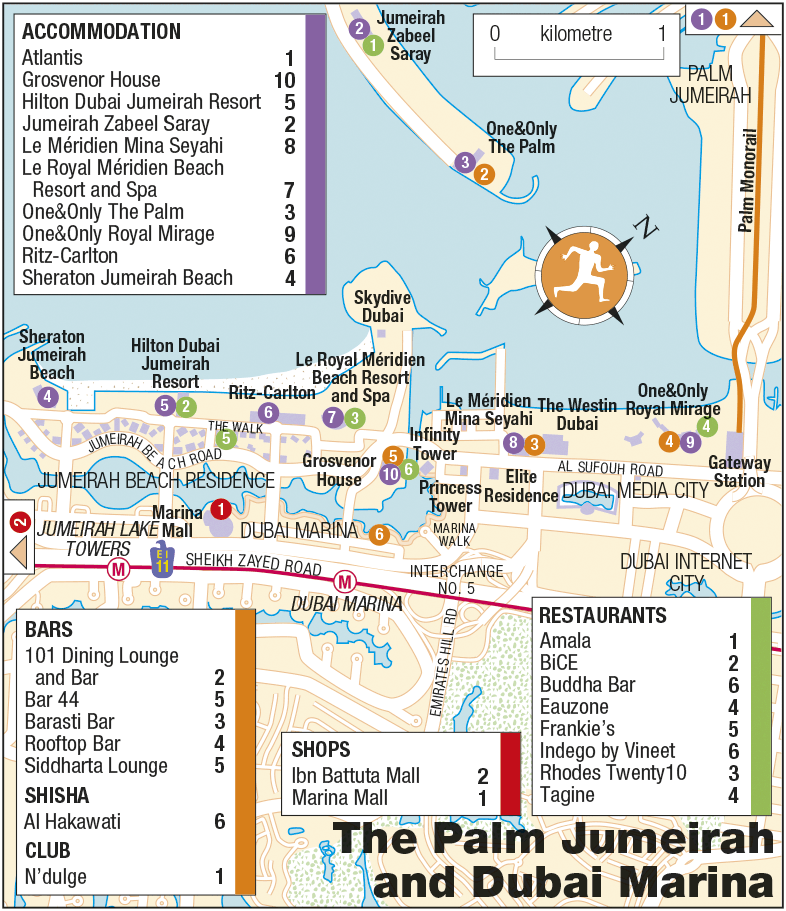
The Palm Jumeirah
Lying off the coast around 5km south of the Burj al Arab and stretching 4km out into the waters of the Arabian Gulf, The Palm Jumeirah – the biggest artificial island in the world – has doubled the length of the Dubai coastline at a total cost of over US$12 billion. As its name suggests, the Palm Jumeirah is designed in the shape of a palm tree, with a central “trunk” and a series of sixteen radiating “fronds”, the whole enclosed in an 11km-long breakwater, or “crescent”, lined with a string of huge, upmarket resorts.
The best way to see the Palm is from the Palm Jumeirah Monorail, whose driverless trains shuttle along an elevated track between the Atlantis resort and the mainland, offering sweeping views over the Palm, although unfortunately the monorail doesn’t connect with the Dubai metro or anywhere else useful.
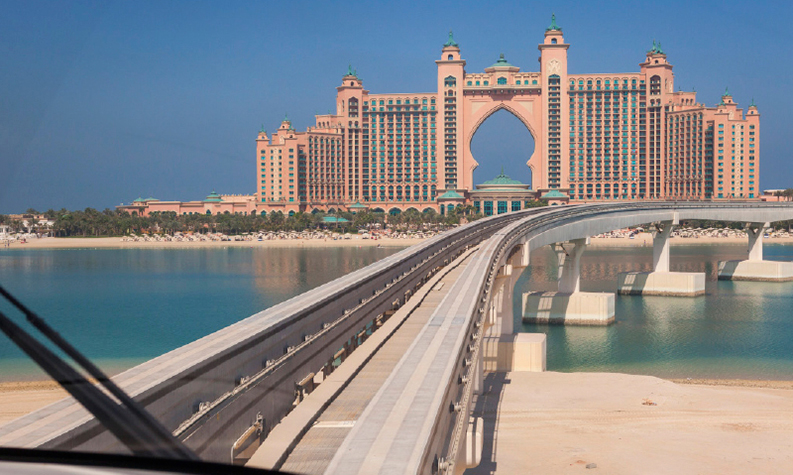
Dubai’s artificial islands
For a city with aspirations of taking over the world’s tourism industry, Dubai has a serious lack of one thing: coast. In its natural state, the emirate boasts a mere 70km of shoreline, totally insufficient for its various needs. Dubai’s solution to its pressing lack of waterfront was characteristically bold: it decided to build some more. The Palm Jumeirah was just the first (and smallest) of four proposed offshore developments. Two further palm-shaped islands – the Palm Jebel Ali, 20km further down the coast, and the gargantuan Palm Deira, right next to the old city centre – were also planned, although work on both has been on hold for several years. The current status of the even more fanciful The World development is similarly uncertain. Lying around 5km off the coast, this complex of artificial islands has been constructed in the shape of an approximate map of the world. Although physical reclamation of the islands has been complete since around 2006, most of the islands remain uninhabited dots of sand in the ocean.
Atlantis
At the furthest end of the Palm Jumeirah, the vast Atlantis resort is the island’s major landmark: an outlandish pink colossus perched over the sea like some kind of weird triumphal arch. What it lacks in architectural taste, it does at least partly make up for in on-site facilities and (pricey) activities. Best is the spectacular Aquaventure waterpark, featuring an adrenaline-charged array of rides and slides centred on the dramatic “Ziggurat”, where you’ll find the park’s headline Leap of Faith waterslide – 27.5m tall, it catapults you at stomach-churning speed down into a transparent tunnel amid a lagoon full of sharks. There are further watery attractions at Dolphin Bay, next door, which offers visitors the chance to swim with the hotel’s troupe of resident bottlenose dolphins.
Alternatively, head to The Lost Chambers, a sequence of halls and tunnels running through the hotel’s vast underground aquarium, populated by an extraordinary array of 65,000-odd tropical fish and dotted with assorted Atlantis-style “ruins”.
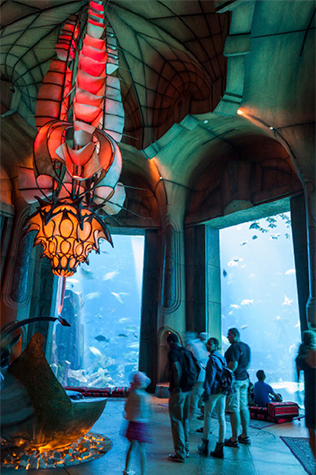
Dubai Marina
A vast phalanx of tightly packed high-rises signals the appearance of Dubai Marina, Dubai’s brand-new city-within-a-city, built at lightning speed since 2005. Like much of modern Dubai, the marina is a mishmash of the good, the bad and the downright ugly. Many of the high-rises are of minimal architectural distinction, and all are packed so closely together that the overall effect is of hyperactive urban development gone completely mad. The whole area feels oddly piecemeal and under-planned, while the lack of pedestrian facilities (excepting the pleasant oceanfront promenade and Marina Walk) means that you’re unlikely to see much more of it than can be glimpsed while speeding down Sheikh Zayed Road by car or metro.
It’s weirdly impressive, even so, especially by night, when darkness hides the worst examples of gimcrack design and the whole area lights up into a fabulous display of airy neon (or, if you prefer, a display of high-rise ecological catastrophe waiting to happen).
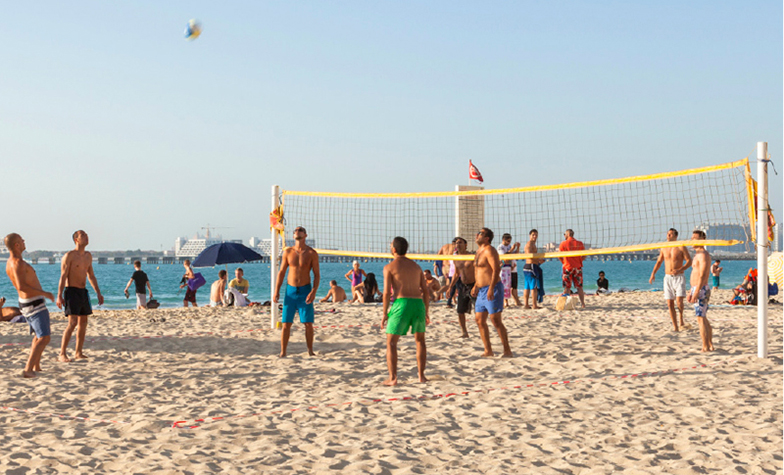
Marina beaches
All Dubai’s beach hotels allow non-guests to use their beaches, swimming pools and other facilities for a (usually hefty) fee, although some places close to outsiders when occupancy levels rise above a certain percentage. Rates vary from around 100dh per day midweek at the Sheraton Jumeirah Beach up to 500dh at the Ritz-Carlton. Given the wallet-emptying amounts of money involved, many people prefer to head to the stretch of free beach between the Sheraton and Hilton hotels, which has plenty of white sand to loll about on, though there are several other free or cheap beaches. All the marina beach hotels have watersports centres, offering a wide range of activities including windsurfing, sailing, kayaking, waterskiing, wake-boarding and parasailing (but not jet-skiing, which the authorities have banned).
Dubai Internet and Media cities
At the north end of Dubai Marina lie Dubai Internet City and Dubai Media City – the first and most successful in a string of dedicated business areas set up by the government to lure foreign firms to the city under preferential commercial terms. There’s not much really to see here, though travelling up and down Sheikh Zayed Road or on the metro you can’t fail to notice the soaring Al Kazim Towers – a pair of quirky skyscrapers styled after New York’s iconic Chrysler Building.
Jumeirah Beach Residence and the Walk
Most of Dubai Marina’s tourist development is focused on the string of luxurious beachside hotels which established themselves here when the coast was largely undeveloped, but now find themselves tragically hemmed in by densely packed high-rises on all sides. Notable among these is the unlovely Jumeirah Beach Residence (JBR): a 1.7km-long sprawl of forty high-rises with living space for ten thousand people. The JBR’s one redeeming feature is The Walk, an attractive promenade lined with boutiques, pizzerias, coffee shops, burger joints and fast-food outlets – one of the very few places in the new city which positively encourages people to get out of their cars. It also boasts a modicum of street life including, during winter months, the pleasant Covent Garden Market, with stalls selling clothes, jewellery and other collectibles.
Marina Walk
Dubai’s marina is actually a man-made sea inlet, lined with luxury yachts and fancy speedboats, which snakes inland behind the JBR, running parallel with the coast for around 1.5km. Encircling the water is the attractive pedestrianized promenade known as Marina Walk, its long straggle of waterfront cafés and restaurants enjoyably lively after dark. Presiding over the northern sea inlet into the marina is the quirky Infinity Tower (330m), the latest in Dubai’s increasingly long list of iconic skyscrapers and instantly recognizable thanks to its distinctively twisted outline, which rotates through 90 degrees from base to summit – a bit like the famous Turning Tower in Malmö, Sweden.
Various kiosks around Marina Walk offer a mix of expensive boat charters alongside much cheaper dhow cruises for those who want to take to the water.
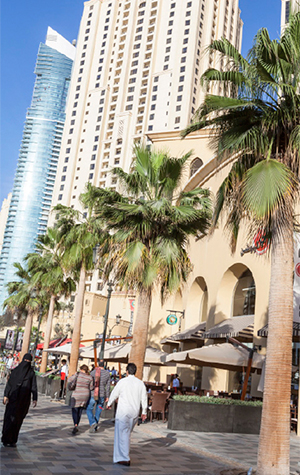
Dubai: the world’s tallest city
Dubai is now officially the tallest city on the planet: at the time of writing it was home to 23 of the world’s 100 highest buildings. By comparison, traditional high-rise hotspots Hong Kong and Chicago muster just seven top-100 buildings apiece, while New York and Shanghai manage just four – the same as Abu Dhabi. The landmark example of Dubai’s sky-high ambition is provided by the staggering Burj Khalifa, while other high-rise icons include the Burj al Arab and the glittering Emirates Towers, as well as less well-known buildings such as the twin towers of the recently opened JW Marriott Marquis Dubai, the world’s tallest hotel.
IBN Battuta Mall
The outlandish, mile-long Ibn Battuta Mall is undoubtedly Dubai’s wackiest shopping experience. The mall is themed in six different sections after some of the places – Morocco, Andalucia, Tunisia, Persia, India and China – visited by the famous Arab traveller Ibn Battuta. Highlights include a life-size elephant complete with mechanical mahout (rider), a twilit Tunisian village and a full-size Chinese junk, while the lavishness of some of the decoration would seem more appropriate on a Rajput palace or a Persian grand mosque than a motorway mall.
< Back to The Palm Jumeirah and Dubai Marina
Shops
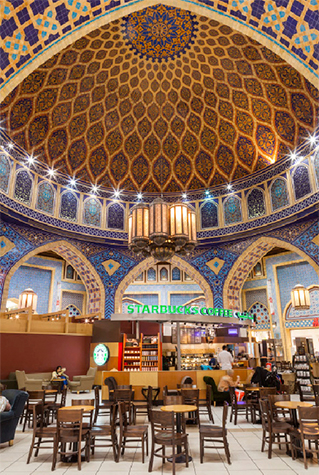
IBN Battuta Mall
This Ibn Battuta-inspired mall is worth a visit for its stunning decor alone – although as a shopping experience it’s a bit underpowered. Shops include a handy Borders bookstore, a well-stocked branch of the local Toy Store chain and the chic Ginger & Lace ladieswear boutique – and it’s worth a look at the entertaining Daiso in the Andalucia court, a kind of Japanese pound shop with everything for 7dh.
Marina Mall
Aimed more at local marina residents than visiting tourists, this bright modern mall is worth a visit if you’re in the area and fancy a bit of clothes shopping (the central atrium looks like a kind of postmodern temple of designer brands), but not worth a special visit otherwise.
Restaurants
Amala
The most popular of the Zabeel Saray’s stunning collection of restaurants, as opulently decorated as a Bollywood film set and with decent North Indian cooking. The fixed price of 285dh per head allows you to order as much as you like from the à la carte menu – good value, assuming you arrive sufficiently hungry.
Bice
Polished modern Italian –reckoned by some to be best in the southern city – serving up tasty pizzas and pastas (70–90dh) bursting with fresh ingredients and flavours, plus a mix of more elaborate meat and seafood mains (from 170dh).
Buddha Bar
Modelled after the famous Parisian joint, this superb bar-restaurant is a sight in its own right: a huge, sepulchral space hung with dozens of red-lantern chandeliers. The menu features a fine array of Japanese and pan-Asian cooking – pricey (mains around 200dh), but worth it for the ambience. Advance reservations recommended.
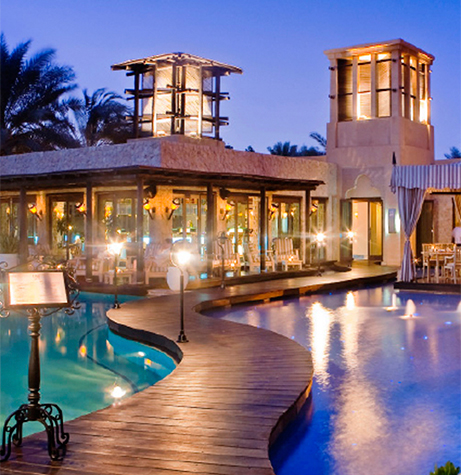
Eauzone
Regularly voted Dubai’s most romantic restaurant with seating amid the beautifully floodlit waters of one of the hotel’s swimming pools. The obligatory evening set menus (from 260dh) feature European meat and seafood dishes, some with an Asian twist. Reserve ahead.
Frankie’s
The foodie lovechild of champion jockey Frankie Dettori in association with Marco Pierre White, this cosy restaurant has a casual bistro feel, with hints of American family diner and a mixed Italian menu of reasonably priced pizzas and pastas (from 70dh), plus fancier meat and seafood mains (from 150dh).
Indego by Vineet
Overseen by Vineet Bhatia, India’s first Michelin-starred chef, this stylish restaurant showcases his contemporary Indian cooking, blending subcontinental and international ingredients and techniques to unusual effect. Mains 140–220dh.
Rhodes Twenty10
Casual and affordable, Gary Rhodes’ second Dubai restaurant features an excellent range of “European-inspired cuisine infused with a touch of the Middle East” alongside burgers, steaks and British classics like steak-and-kidney pie. Most mains 120–190dh.
Tagine
Sumptuous little Moroccan restaurant, the beautiful Moorish decor complemented by authentic North African cooking including classics like pastilla (pigeon pie), tangia and a selection of delicious tagines. Mains around 100dh.
Bars
101 Dining Lounge and Bar
Overlooking the swish new One&Only The Palm’s private marina, 101’s big draws are its gorgeous terrace over the water outside (live DJ most evenings) and stunning views across to the marina’s skyscrapers opposite.
Bar 44
This svelte contemporary bar offers peerless 360-degree views of the entire marina development, with twinkling high-rises stretching away in every direction and a big selection of wallet-emptying champagnes, cool cocktails and other designer beverages.
Barasti Bar
Fun, two-level beachside bar popular with an eclectic crowd. Downstairs is usually more Ibiza chill-out, with ambient music, shisha and loungers on the sand; the pubbier upstairs is generally noisier, with live DJs and a party atmosphere.
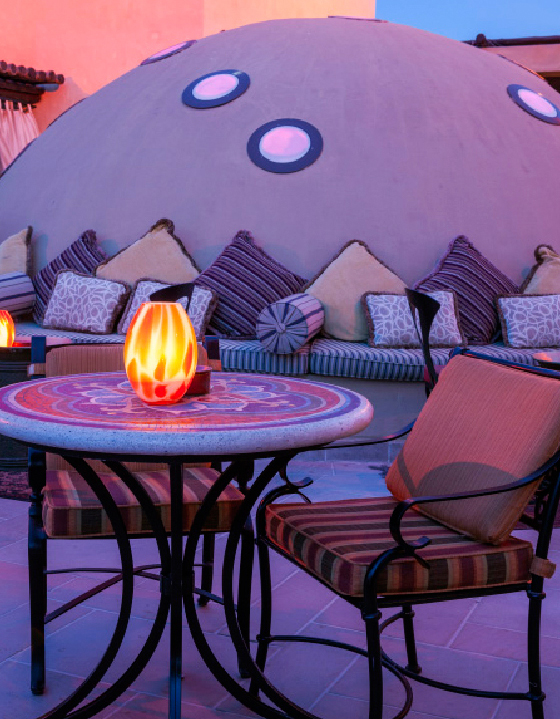
Rooftop Bar
One of Dubai’s ultimate Orientalist fantasies, with seductive Moorish decor, cushion-strewn pavilions, silver-tray tables and other assorted Arabiah artefacts. A smooth live DJ adds to the One Thousand and One Nights ambience.
Siddharta Lounge
Swanky new venue with a cool poolside terrace and bar outside and a “palm area” with shisha lounge within – all snowy-white decor with the occasional gold armchair. Food and drinks are ordered off the menu of the adjacent Buddha Bar.
Shisha
Al Hakawati
Though the sign’s easy to miss, this lively café is pretty obvious, with an eye-catching scatter of red, kilim-covered sofas shaded by a little grove of potted trees. There are ten types of shisha on offer (21dh), and the food – a mishmash of Arabian and Western – isn’t bad either.
Club
N’dulge
Dubai’s leading super-club, with space for around 3000 punters on its two big dancefloors inside and a lovely chill-out and shisha terrace outside. The eclectic music policy, with different tunes in each of the three areas, means you should find something you like.